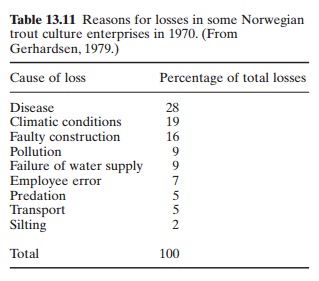Chapter: Aquaculture Principles and Practices: Marketing of Aquaculture Products
Risk and insurance - Economics and Financing of Aquaculture
Risk and insurance
Even though comparative figures are not readily available, it is
generally held that the risk in aquaculture is substantially greater than that
in any other form of animal husbandry (Gerhardsen, 1979) and this is mainly due
to the fact that production takes place in water, which is not easily observed
and controlled by man. It is said that there are very few other stock-rearing
industries that are so exposed to such a rapid and extensive loss of stock from
so many varied causes (Secretan, 1979). Risks of loss or loss of value have
been broadly listed as: pollution, disease, food poisoning, failure of water
supply, break-down of equipment and machinery, net and cage failure, predation,
extreme (hot or cold) weather conditions, power failure, poaching, negligence,
floods and other natural disasters like cyclones, typhoons and hurricanes and
malicious damage. Of these, which ones account for maximum losses is difficult
to say. Gerhardsen (1979) published the result of an investigation of trout
culture in Norway (Table 13.11) which showed that disease was the most frequent
reason for losses.
Secretan (1986) reported that over 20 per cent of losses handled by the
Aquaculture Insurance Service of England were due to diseases. Pollution, which
was expected to be a major cause of loss, accounted for only 3.65 per cent of
the losses. When it is remembered that many of the serious diseases have no
known cures, and infected fish have to be destroyed, the magnitude of the risk
involved will become evident. To the risks mentioned above should be added
other business risks like price risk and other sundry risks like claims on
customers and advances to suppliers.

This high-risk status seriously affects the availability of venture capital
for aquaculture. In evaluating investments, cash flows are discounted at a
high-risk rate and this may affect the attractiveness of the project to
investors.
A means of limiting the risk of an owner’s capital is the formation of
companies, for example a joint stock company or limited partnership, with
limited liabilities (Gerhardsen, 1979). However, this only helps to limit
individual risk. Insurance, when possible, is probably a better way of covering
risk and represents security of the interests of all those who are financially
interested in the venture, including investors, shareholders, bankers and
suppliers of equipment and supplies. An insurance on the important insurable
interests of an operation will probably make it easier for even a small operator
to obtain the necessary bank credit. Aquaculture insurance is a new and
developing industry and presently serves mostly industrially advanced countries
only.
Insurance is concerned with the spreading of risks and hazards of the
industry among policy holders. Being a new industry dealing with a high-risk
activity, both the underwriters and insurers face problems in choosing the type
of risks to be covered. Premium rates remain high because of the absence of any
track record for the insured and the large number of claims that the insurers
have to settle.
The most important asset to be insured in an aquaculture enterprise is
the stock of species raised. As most of the risks listed earlier are
interrelated and not adequately defined for legal purposes, an ‘all risks’
coverage may be the best guarantee. It may be possible to exclude from this
selected individual risks (i.e. risks considered not applicable or important)
and thus reduce the premium to be paid.
The main areas of liability that are important in aquaculture are
employers’ liability, public liability and products liability. Depending on the
legal system in the country, provision can be made to meet these through
insurance coverage. Employer’s liability or workmen’s compensation is fairly
easily determined, based on the nature of the work carried out by them. Public
liability can involve somewhat more complicated situations. This could include
third-party personal injury or property damage, especially in open-water cage
or raft culture. In countries where products liability laws exist, it is
important to have insurance coverage for this. Death or disability caused by
the consumption of contaminated aquaculture products or damage caused by the
supply of infected fry or fingerlings can result in payment of considerable
compensations.
Risk management that can be effected through cooperation with the
insurance industry relates to pure risks as opposed to business risks. These
pure risks include (i) natural disasters, (ii) technical (breakdown and failure
of equipment and plants), (iii) theft, poaching, negligence and (iv) personal
risks. It is believed that losses due to all these can be reduced by proper
management practices, making use of the experience of insurers (Secretan,
1979).
Related Topics